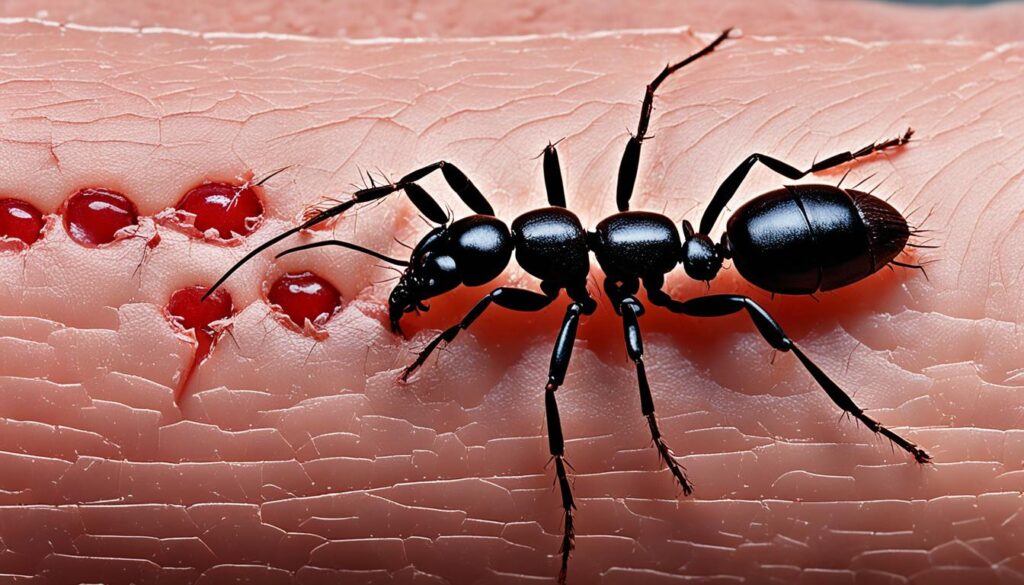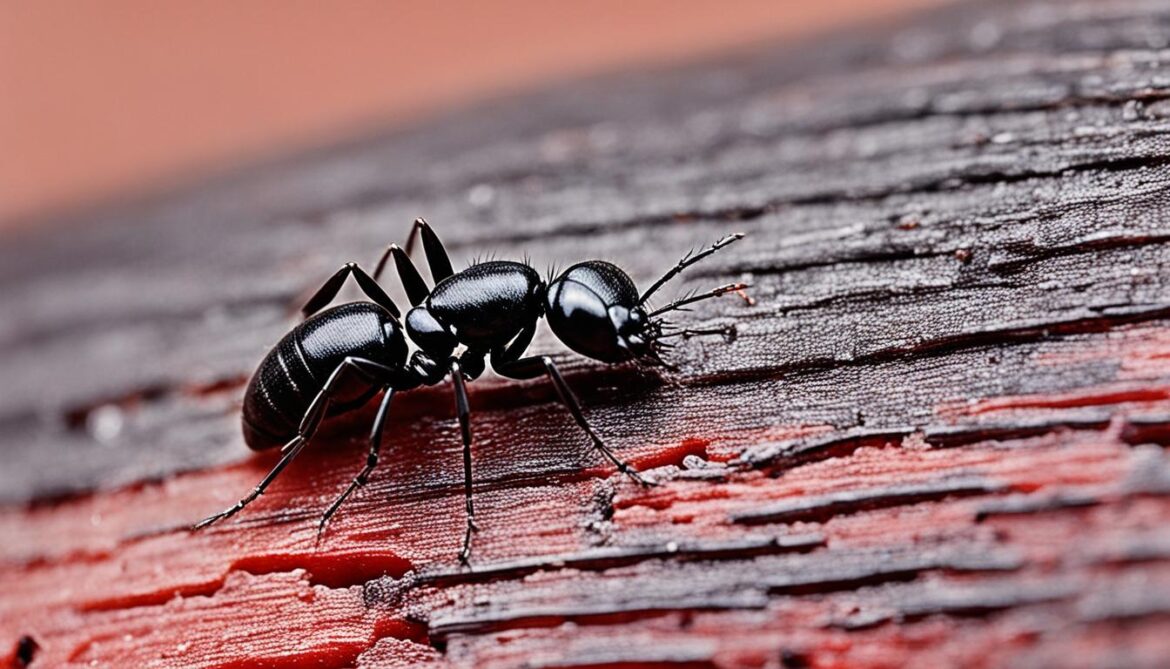Carpenter ants are black, red, or brown ants that tunnel through wood to form colonies. While they rarely bite humans, it’s important to be aware of the symptoms and treatment for carpenter ant bites. Understanding the identification, prevention, and treatment options can help alleviate any discomfort caused by these bites.
Key Takeaways:
- Carpenter ants are black, red, or brown ants that tunnel through wood to form colonies.
- Carpenter ant bites are generally mild, causing a burning sensation and possible redness.
- It’s crucial to differentiate between carpenter ant bites and bites from other insects that may cause more severe reactions.
- Carpenter ants can be prevented by eliminating sources of water, repairing areas with moist wood, and keeping wood piles away from your home.
- Most carpenter ant bites can be managed at home with simple first aid measures, such as washing the affected area and applying cold compresses.
How to Identify Carpenter Ant Bites
In order to properly identify carpenter ant bites, it is essential to understand their appearance and symptoms. Carpenter ant bites typically manifest as small, red blemishes that resemble pimples. However, it’s important to note that these bites can easily be mistaken for other types of insect bites.
When a carpenter ant bites, it uses its sharp mandibles to pierce the skin, often leaving behind a small red bump. The bites may cause slight itching and a burning sensation.
It is crucial to differentiate carpenter ant bites from bites caused by other insects to ensure appropriate treatment. By being aware of the appearance and symptoms, one can accurately identify carpenter ant bites and seek the necessary care.

Appearance of Carpenter Ant Bites
- Small, red blemishes resembling pimples
Symptoms of Carpenter Ant Bites
- Slight itching
- Burning sensation
Carpenter ant bites do not pose a significant risk of infection. However, individuals experiencing persistent or worsening symptoms, or anyone with concerns, should consult a healthcare professional for further evaluation and guidance.
Treatment for Carpenter Ant Bites
Most carpenter ant bites do not require specific treatment and can be managed at home. If bitten, wash the affected area with warm water and soap to remove any formic acid irritants. Applying a cool cloth or ice pack to the bite can help reduce itching and provide relief. Over-the-counter hydrocortisone creams or ointments can also be applied to alleviate itchiness. It’s important to avoid scratching the bite, as it may lead to further irritation or infection. If the symptoms worsen or if you develop a fever, it’s advisable to seek medical attention, as it may indicate an infection or allergic reaction.
Prevention of Carpenter Ant Bites
To prevent carpenter ant bites, it’s essential to take proactive measures to eliminate infestations in and around your home. By implementing the following strategies, you can significantly reduce the risk of encountering carpenter ants and their bites:
1. Remove Sources of Water Near Colonies
Carpenter ants are attracted to areas with moisture. Eliminating water sources near ant colonies, such as leaky pipes or standing water, can discourage them from establishing nests in your vicinity.
2. Repair Areas with Moist Wood
Carpenter ants are drawn to moist, decaying wood. Regularly inspect your home for areas with moisture damage, such as leaky roofs or water-damaged wood, and promptly repair them to prevent infestations.
3. Keep Wood Piles and Other Lumber Away from Your Home
Storing firewood, lumber, or other wooden materials too close to your home can attract carpenter ants. Keep these items at a distance to minimize the likelihood of ants migrating to your living spaces.
4. Ensure Plants and Trees Don’t Touch Your House
Carpenter ants often use tree branches or shrubs as bridges to access homes. Trim vegetation that comes into contact with your house to create a barrier that prevents ants from easily accessing your property.
5. Seal Cracks in Windows
Carpenter ants can find their way into your home through small openings in windows or doors. Seal any cracks or gaps with suitable caulking to prevent ants from entering your living spaces.
6. Regular Inspections and Professional Pest Control Services
Schedule regular inspections of your property to identify early signs of carpenter ant activity. Professional pest control services can help detect and eliminate any existing carpenter ant colonies, minimizing the risk of bites and infestations.
By following these preventative measures, you can protect yourself and your home from carpenter ants and ensure a bite-free environment.
| Preventive Measure | Description |
|---|---|
| Remove Sources of Water Near Colonies | Eliminate any standing water or moisture sources near ant colonies to discourage their presence. |
| Repair Areas with Moist Wood | Regularly inspect your home for moisture damage and promptly repair any areas with decaying or moist wood. |
| Keep Wood Piles and Other Lumber Away from Your Home | Store firewood and lumber at a distance from your home to prevent carpenter ants from being attracted to the vicinity. |
| Ensure Plants and Trees Don’t Touch Your House | Trim vegetation that comes into contact with your house to create a barrier against carpenter ants. |
| Seal Cracks in Windows | Seal any cracks or gaps in windows and doors to prevent ants from entering your living spaces. |
| Regular Inspections and Professional Pest Control Services | Schedule regular inspections and consider seeking professional pest control services to detect and eliminate carpenter ant colonies. |
Implementing these preventive measures can help safeguard your home and prevent carpenter ant bites. By taking proactive steps and maintaining a vigilant approach, you can enjoy a pest-free living environment.
Conclusion
In conclusion, carpenter ant bites are generally harmless and do not cause significant health issues. While these ants may bite humans, their bites are usually mild, characterized by possible redness and a burning sensation. It is essential to properly identify carpenter ant bites to differentiate them from bites of other insects. Most carpenter ant bites can be managed at home with simple first aid measures.
If the symptoms of a carpenter ant bite worsen or persist, seeking medical attention is advisable. This is particularly important if there is swelling, long-lasting pain, fever, or signs of infection at the bite site. It’s also essential to take preventive measures to minimize the risk of carpenter ant bites. Regular inspections of your home and property, along with professional pest control services, can help detect and eliminate any carpenter ant colonies.
By following proper identification, treatment, and prevention guidelines, you can ensure a safe and pest-free environment for yourself and your family. Remember to stay vigilant and take necessary measures if you encounter carpenter ant bites or suspect an infestation. By doing so, you can minimize the impact of these bites and maintain a comfortable living space free from carpenter ant-related concerns.
FAQ
What are the symptoms of a carpenter ant bite?
The symptoms of a carpenter ant bite are generally mild, with possible red coloration and a burning sensation.
How can I identify a carpenter ant bite?
Carpenter ant bites may appear as small, red blemishes that resemble pimples. They can easily be mistaken for other types of insect bites.
What is the treatment for carpenter ant bites?
Most carpenter ant bites do not require specific treatment and can be managed at home. Washing the affected area, using a cool cloth or ice pack, and applying hydrocortisone creams or ointments can help alleviate symptoms.
How can I prevent carpenter ant bites?
To prevent carpenter ant bites, it’s important to take measures to prevent infestations in and around your home. This includes removing sources of water near colonies, keeping wood piles and other lumber away from your home, and sealing cracks in windows.







